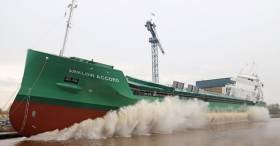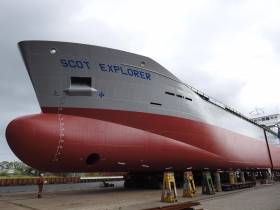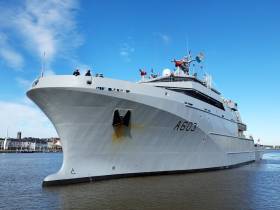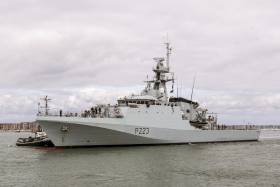Displaying items by tag: Newbuild
A New Accord Brings Further Expansion of Arklow Shipping Fleet
Arklow Accord is the latest of a new series for ship-owner Arklow Shipping Ltd, however the bulk oriented cargo vessel is also a first for the company to use this ship name, writes Jehan Ashmore.
The launching of newbuild Arklow Accord (Nb. 438) which took place on Friday, represents the second of a six ships using the Arklow 'A' naming scheme. The order by ASL is with shipbuilder Ferus Smit at their Dutch shipyard located in Westerbroek.
Currently the company have almost 60 vessels including Dutch division Arklow Shipping Nederland B.V. and this milestone is to be exceeded with the roll-out of the Arklow A - series.
The design of Arklow Accord will see its operations chiefly employed in the shipment of corn, wheat and other bulk commodities in European waters.
The inland yard at Westerbroek, is where Irish flagged leadship Arklow Abbey was also given the customary launched sideways in July and with the newbuild entering service two months later.
According to Ferus Smit, the design is a slightly modified version of the first series of 8600dwt bulkers that the shipyard built under the Arklow B – series. The new design is adapted for iceclass 1A, with modified bow form and propulsion with a propeller nozzle added.
At the same time, the main engine output was decreased to 2000 kW for better fuel efficiency.
Listed below are the basic characteristics of Arklow Accord:
– Loa = 119.495 mtr
– Lpp = 116.895 mtr
– B = 14.99 mtr
– D = 9.70 mtr
– T max = 7.160 mtr
– Hold volume = 350.000 cft
The delivery of the Arklow registered newbuild is due for January 2020.
Visitor Returns to Ireland As New French Naval Vessel Calls to Cork City
To those in Cork City this weekend and travelling down J.J. Horgan's Quay may have noticed a sleek new naval arrival making its way upriver to the quay.
According to CorkBeo, the shiny arrival is a new French Naval ship, Rhône. It was only launched this year, so get down to see this while you can!
The newbuild is a support vessel of the French Navy which entered service this year and as Afloat reported in the summer Rhône made a first visit to Ireland. On that occasion it was to the Port of Waterford.
For more on this current call to Cork, click here, before the naval visitor departs the city on Monday morning.
Second of Three Ship Order Launched for UK Forest Products Operator Which Serves Irish Ports
Scot Explorer became the latest launch for a UK shipping forests products operator, following a christening ceremony that was held at a Dutch shipyard yesterday, writes Jehan Ashmore.
The launch (footage) of newbuild (NB 747) at the Royal Bodewes yard in Hoogezand marked the second of a three-ship order confirmed from Scotline which has its headquarters based in Romford, Kent.
Unlike leadship Scot Carrier launched last year, the latest newbuild of the trio of 4,800dwt sisters, differs having enclosed bridge wings, in order to make manoeuvring easier. The newbuild is due to be completed next month.
As for the final timber products carrier, this newbuild to be named Scot Ranger is scheduled to be delivered at the end of 2020.
Scotline primarily runs liner services throughout northern Europe with regular routes between Sweden, Ireland, Denmark, Germany, Norway and the Baltic States. In addition to those serving the UK, Netherlands and France.
Irish Lights English Counterpart Trinity House to Commission New Vessel Announced At LISW19
Irish Lights counterpart serving the waters of England, Wales and the Channel Islands, Trinity House has launched a Vessel Replacement Project to commission the design and build of a vessel to replace THV Patricia. The vessel was delivered in 1982 and is reaching the end of its operational life.
The announcement was made at a launch event at Trinity House in London yesterday, during London International Shipping Week (LISW19). Attending the event was Maritime Minister Nusrat Ghani and where a contract notice was issued to the shipbuilding industry to open the procurement process.
The Minister announced her support for the project in July 2019, following a comprehensive Fleet Review that concluded that the three General Lighthouse Authorities of the UK and Ireland (Trinity House, Northern Lighthouse Board and Irish Lights) require seven vessels to deliver their critical aids to navigation service.
The new vessel will look to harness technological and environmental innovation to ensure that Trinity House continues to provide over 600 critical aids to navigation—such as lighthouses and buoys—for ships and seafarers in some of the most dangerous waters in the world, guiding them into safe channels away from hazards and wrecks.
Nusrat Ghani, Maritime Minister, said: “95% of our imports and exports are transported to and from the UK by sea and, with our waters becoming even busier, dealing with incidents quickly and efficiently is more important than ever. This new ship will support the General Lighthouse Authority to help future-proof their fleet and continue to support maritime trade for generations to come.”
Captain Ian McNaught, Executive Chairman of Trinity House, said: “We were pleased to hear that the Maritime Minister was content for us to move the Vessel Replacement Project closer towards the design and build phase. While we must ensure that value for money is central to the design, we will also be looking for new, tested and robust technologies in the vessel design; these technologies will need to offer high performance and resilience and also reduce our environmental impact.”
A French Navy offshore support and assistance vessel which was commissioned into service earlier this year visited Waterford City over the weekend, writes Jehan Ashmore.
The impressive Loire class or Metropolitan Support and Assistance Building (BSAM) Rhône entered service in January. This call to the 'Crystal City' was a maiden first to Ireland as the 70m newbuild berthed on the Suir at the Frank Cassin Wharf.
This part of the port on the Co. Kilkenny side was where Bell Lines lo-lo terminal was located before shifting downriver to Belview, the current main terminal of the Port of Waterford.
BSAM Rhône entered service in January as the second of pair following leadship BSAM Loire that form part of the unarmed support ships serving the French Navy. The newbuild built in Brittany at the Piriou shipyards of Concarneau was developed in a programme named the Kership. The joint venture was created in 2013 by Piriou (55%) and DCNS (45%).
The newbuild which has a displacement of 2960 tons has a propulsion system derived from two diesel engines that delivers a speed of 14 knots. A crew consists of 17 sailors in addition to an option for 12 divers.
This morning the naval visitor is scheduled to depart the Suir.
Following the Rockall fishery dispute that grabbed the headlines last week, the UK's newest Fishery Patrol Vessel (FPV) completed a delivery voyage from Scotland to its homeport of Portsmouth today, writes Jehan Ashmore.
HMS Medway arrived on Solent waters this morning. The newbuild is the second of five new British Royal Navy Batch 2 River-class offshore patrol vessel (OPV) currently under construction on the Clyde at BAE Systems Scotstoun yard.
The final Batch 2 river class OPV HMS Spey was on Friday taken out of the shipyard's Block Outfit Hall and positioned onto the hard stand ready to be loaded onto the launch barge.
BAE's shipyard is located upriver of the striking multi-award winning Riverside Museum in Glasgow where Afloat visited the iconic building designed by the Iranian born architect, the late Zaha Hadid.
As for the design of the HMS Medway and its future function, according to the Royal Navy they they will not use the Batch 2 class primarily for safeguarding fishing stocks in home waters but ‘forward deploy’ around the world. In addition to fishery duties, the class are designed to carry out counter-terrorism and anti-smuggling requirements in order to safeguard the UK's borders.
The new class each of 2000 tonnes will according to Naval Technology are to replace the Royal Navy’s current River-class patrol ships, including HMS Clyde, Severn, Tyne and Mersey. See report of Dublin Port call of the Liverpool based OPV and related role in the UK Government's Brexit contingency fund plan.
Leadship of the class is HMS Forth which like the rest of the class could find themselves on patrol in the Atlantic, the Caribbean, Mediterranean or the Pacific rim operating from Singapore.
In December HMS Medway took its first sea trials along the Firth of Clyde and from where Afloat last Friday had traced the OPV back to the Faslane Naval Base on Gare Loch having departed the previous day. Faslane is the homeport of the Royal Navy's Trident class nuclear powered submarines.
The course set by HMS Medway also revealed further sea trails exercises that took place in the southern waters of the Firth of Cyde. This involved an area between Ardrossan in Ayrshire and Ailsa Craig, an impressive rocky islet.
On the following day (Friday) HMS Medway was tracked by Afloat when its reached the centre of the St. Georges Channel. It is in these waters where the temporary Rosslare-Fishguard ferry Stena Nordica (deputing for Stena Europe) had already proceeded beyond mid-channel during a routine morning sailing to the Pembrokeshire port in south-west Wales.
According to AIS system, HMS Medway achieved a speed of 24.9 knots while in relatively close quarters of an Irish flagged dry-cargoship the Arklow Cliff. At just three metres shorter in length compared to the 90m naval newbuild, the 2,999grt cargoship had too set a southerly course.
Arklow Cliff Afloat featured its launch just two years ago and on this occasion as an operational ship was tracked underway while making a more sedate speed of 11.9 knots. By coincidence Arklow Cliff was bound for the River Medway where the town and Port of Rochester is located about 30 miles east of London.
Arklow Cliff likewise of HMS Medway had departed its last port last Thursday, but from Warrenpoint in Co. Down. The short-sea trader arrived in the north Kent port yesterday having sailed along the Thames Estuary from where on the southern shore the cargoship entered the Medway to approach Rochester.
Forest Products Carrier Takes to the Seas for First Trials
#Ports&Shipping- Specialist forest carrier operator, ScotLine which operates regular services to Irish ports, last week saw their latest newbuild take to the seas for first trails, writes Jehan Ashmore.
Since Scot Carrier's christening launch ceremony in September, the 4,800dwt short-sea timber trader, now the largest of the fleet has undergone outfitting. Last week the 90m long cargoship which has a beam of 15m departed on a canal journey under towage from the Dutch inland shipyard of Royal Bodewes in Hoogezand to Delfzijl.
From there Scot Carrier sailed under its own propulsion (Mak engine) to Eemshaven having made the passage through the Ems Estuary to enter the open sea. According to Royal Bodewes the inaugural sea trial in the North Sea was successfully executed.
Furthermore, Afloat today tracked Scot Carrier undergoing trials again having departed Emshaven, from where the newbuild is at time of writing offshore of Esbjerg, Denmark.
Scot Carrier has been given an ice class 1B classification which is important for Baltic customers of the operator, which primarily runs 'liner' services around Northern Europe with regular routes between Ireland, Denmark, Sweden, Norway and Germany. In addition to liner links calling to ports in the UK, France and The Netherlands.
The newbuild will join fleetmates that in addition to transporting forest products also can vary in loading a variety of bulk and project cargoes.
#Ports&Shipping - Arklow Wave became the first of a quartet of new enlarged versions of ships to be launched at a German shipyard, writes Jehan Ashmore.
Launching of Arklow Wave (no. 447) took place last Friday at Ferus Smit Leer GmbH, for owners Arklow Shipping Ltd with the newbuild to be Irish flagged. The christening occasion involved the customary sideways launch of the newbuild, where the port side of Arklow Wave made contact first with the water.
Leadship Arklow Wave is an enlarged version of the 8,500dwt ships that the shipyard delivered to ASL in the past in which Afloat has identified as the 'B' ship named class (see below). In comparison with these vessels, the newbuilds will have around twice the cargo capacity at almost 16,000dwt. As for the powerplant, a 3840kW main engine will be equipped to achieve low fuel consumption.
The newbuild features a bulbless straight-stem bow design to reduce wave friction, likewise of the predecesors which began with Arklow Beacon in 2014. A final sixth sister of the B class, Arklow Brave was completed the following year.
Ferus Smit's yard in Leer, is a city located in Lower Saxony, on the river Leda which is a tributary of the river Ems. The river flows into the Ems Estuary which shares the border with the Netherlands, where Afloat has previously reported on other Arklow newbuilds taking sea trails based out of Delfzijl.
Below are some main design details about Arklow Wave and sisters.
– Main dimensions (Loa X B X T) 149.50 X 19.25 X 8.59 mtr.
– 16500 DWT, 700.000 cft hold volume.
– Iceclass 1A with 3840kW main engine.
– 2 box shaped holds.
– Propeller equipped with a duct for enhanced thrust at lower speeds and reduction of maximum installed propulsion power.
According to the shipyard, delivery of Arklow Wave is scheduled for October.
#Ports&Shipping - Arklow Viking began sea trials yesterday, the brand new short-sea trader having been towed from an inland Dutch yard to the North Sea, writes Jehan Ashmore.
The 2,999grt Arklow Viking marks the 9th of ten multipurpose cargoships that will serve Arklow Shipping Nederland B.V. The class constructed by Royal Bodewes shipyard are built to an in-house design, the Eco-Trader 5150 series.
It was on Monday, that a pair of tugs towed the 89m Arklow Viking from the yard in Hoogezand near Groningen on the canal network to Delfzijl on the Ems Estuary. The newbuild undertook sea trials and when not underway the vessel in based out of Emshaven.
As for final sister of this series, the newbuild is to be named Arklow Villa and as revealed on the stern, the port of registry is Rotterdam. This is not surprising as ASN are based in the giant deep-water port.
Around 50 cargoships operate under the Irish and Dutch flagged fleet, they mostly comprise of short-sea traders in addition to deep-sea bulkers.
Another Arklow Newbuild On the Stocks Revives Name of Predecessor
#ports&shipping - The latest in a long line of newbuild cargsoship replacements for Arklow Shipping has been identified by Afloat and not surprisingly built in a Dutch shipyard, writes Jehan Ashmore.
A steady succession of new tonnage in recent years has been ordered by ASL from in fact two Dutch yards. On this occasion it is Royal Bodewes based in Hoogezand and where the newbuild has been given yard No. 728. So what is the name of this 8th of 10 newbuilds ordered? The answer is Arklow Venus.
This 'Venus' revives that of a predecessor that belonged to an older generation. That been a trio of smaller cargoships all since been disposed but continue serving other owners.
As for the new V class, they have a 87m long hull that features a straight-stem bow. This is to reduce wave resistance and save on fuel consumption adding to greater efficiencies.
The previous sister, Arklow Vanguard made her launch on 'Bloomsday' and has since entered service.





































































